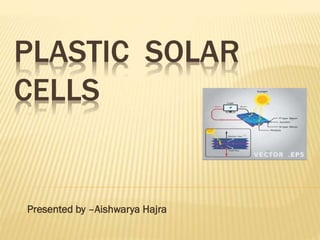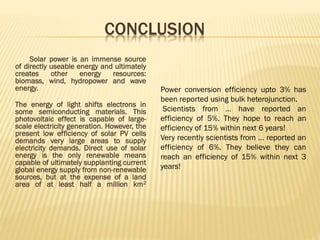Plastic solar cells
- 1. PLASTIC SOLAR CELLS Presented by âAishwarya Hajra
- 2. CONTENTS ï Introduction ï Plastic Solar Cells ï Working Principle of a P-N junction ï Action of Photons ï Uses of Solar cells ï Architecture of Plastic solar cells ï Working principle ( MIM Tunnel Diode ) ï Working principle ( Heterojunction Diode ) ï Production Technique of Solar cells ï Conclusion
- 3. INTRODUCTION An organic solar cell or plastic solar cell is a type of photovoltaic that uses organic electronics, a branch of electronics that deals with conductive organic polymers or small organic molecules, for light absorption and charge transport to produce electricity from sunlight by the photovoltaic effect. Most organic photovoltaic cells are polymer solar cells.
- 4. PLASTIC SOLAR CELLS ï Scientists have invented a plastic solar cell that can turn the suns power into electric energy even on a cloudy day. ï The plastic material uses nanotechnology and contains the 1stgeneration solar cells that can harness the sunâs invisible infrared rays. ï This breakthrough made us to believe that plastic solar cells could one day become more efficient than the current solar cell. ï The researchers combined specially designed nano particles called quantum dots with a polymer to make the plastic that can detect energy in the infrared. Advantage: High efficiency -up to 30% has been reached. Normally 10% for commercial product. Disadvantage: Elaborate and very expensive method required to produce the material.
- 5. WORKING PRINCIPLE OF P-N JUNCTION ï When p-doped and n-doped semiconductors are brought together, a depletion layer is formed. ï The depletion layer sets up an electric field. ï Any charge in the field experiences a force that sweeps it to the end of the depletion layer.
- 6. ACTION OF PHOTONS ï A photon excites an electron from the valence band to the conduction band creating an electron-hole pair. ï The excited electrons in the depletion layer move towards the n-type end while the holes move to the p-type end. ï This flow of charge drives the external load.
- 7. USES OF PLASTIC SOLAR CELLS ï Generating electricity for space vehicles. ï Power for facilities like repeater stations for TV, radio etc. in remote locations. ï Alternative energy source for household purpose where normal electricity is not feasible. ï Power source for small devices like pocket calculators.
- 8. DEVICE ARCHITECTURE ï Simplest design uses organic semiconductor, metal-insulator metal (MIM) tunnel diode. ï The insulator typically is a conjugated polymer. ï A more complicated design uses two conducting polymers differing in electron affinities forming heterojunction.
- 9. WORKING PRINCIPLE OF MIM TUNNEL DIODE ï Conjugated polymers are analogous to inorganic semiconductors. ï The overlap of atomic pi orbitals gives rise to delocalized bonding and antibonding pi orbitals analogous to the valence band and the conduction band. ï Energy gap between the bands is typically 1.5 â 3 eV which lies in the range of the visible light.
- 10. WORKING PRINCIPLE OF HETEROJUNCTION DIODE ï An interface is created between conducting polymers with different electron affinities. ï Such junctions are very effective in splitting the excitons. ï Limitation: Life time of the excitons. Only the excitons formed within ~10 nm of the junction can reach it. âĒ Interpenetrating networks of electron -accepting and electrondonating polymers.
- 11. PRODUCTION TECHNIQUE OF PLASTIC SOLAR CELLS Production of ITO Surface Coating of hole conduction layer by PEDOT:PSS Coating of active layer Device Testing Sealing against Oxygen & Water Evaporation of top contact
- 12. CONCLUSION Solar power is an immense source of directly useable energy and ultimately creates other energy resources: biomass, wind, hydropower and wave energy. The energy of light shifts electrons in some semiconducting materials. This photovoltaic effect is capable of large- scale electricity generation. However, the present low efficiency of solar PV cells demands very large areas to supply electricity demands. Direct use of solar energy is the only renewable means capable of ultimately supplanting current global energy supply from non-renewable sources, but at the expense of a land area of at least half a million km2 Power conversion efficiency upto 3% has been reported using bulk heterojunction. Scientists from âĶ have reported an efficiency of 5%. They hope to reach an efficiency of 15% within next 6 years! Very recently scientists from âĶ reported an efficiency of 6%. They believe they can reach an efficiency of 15% within next 3 years!











